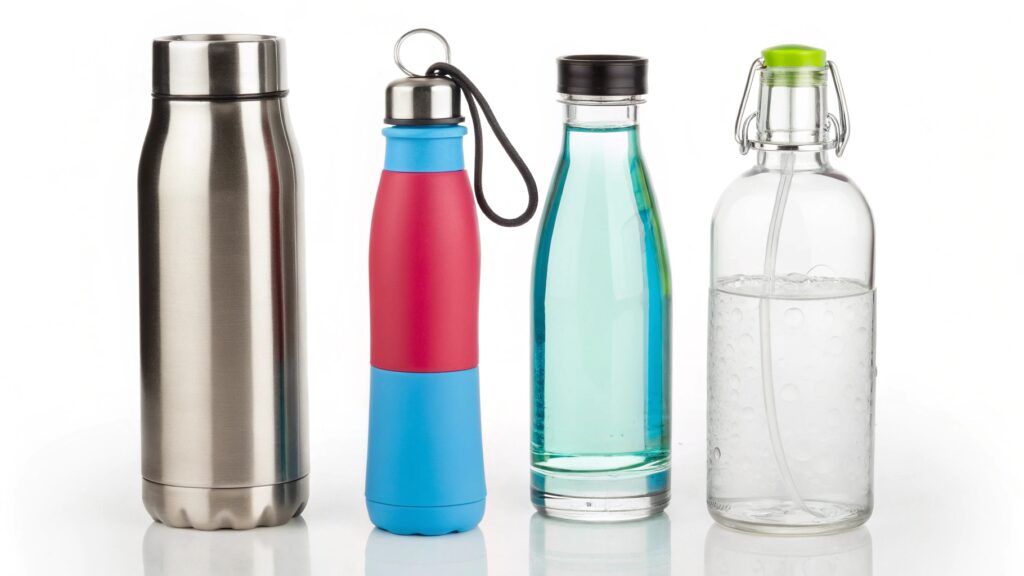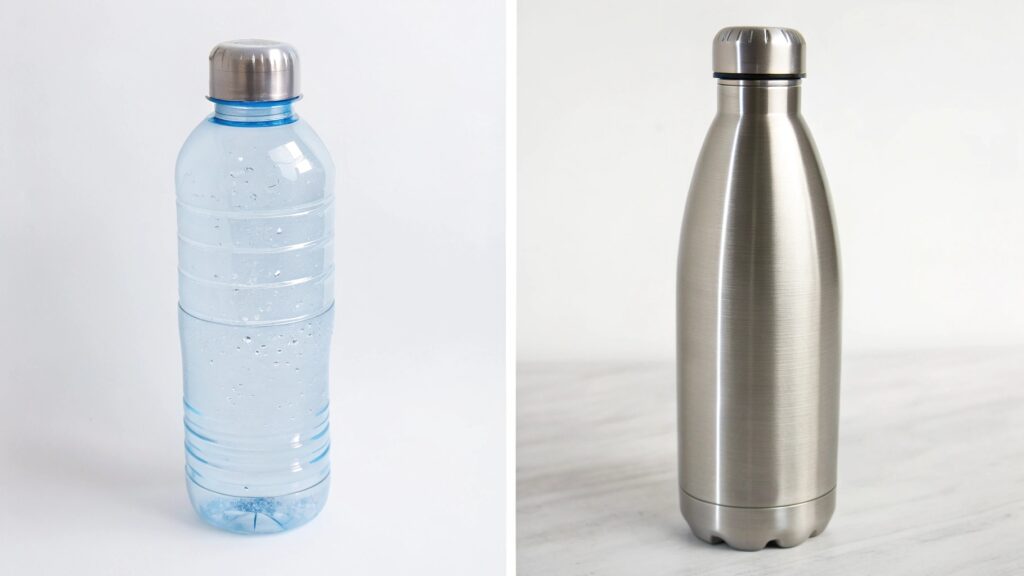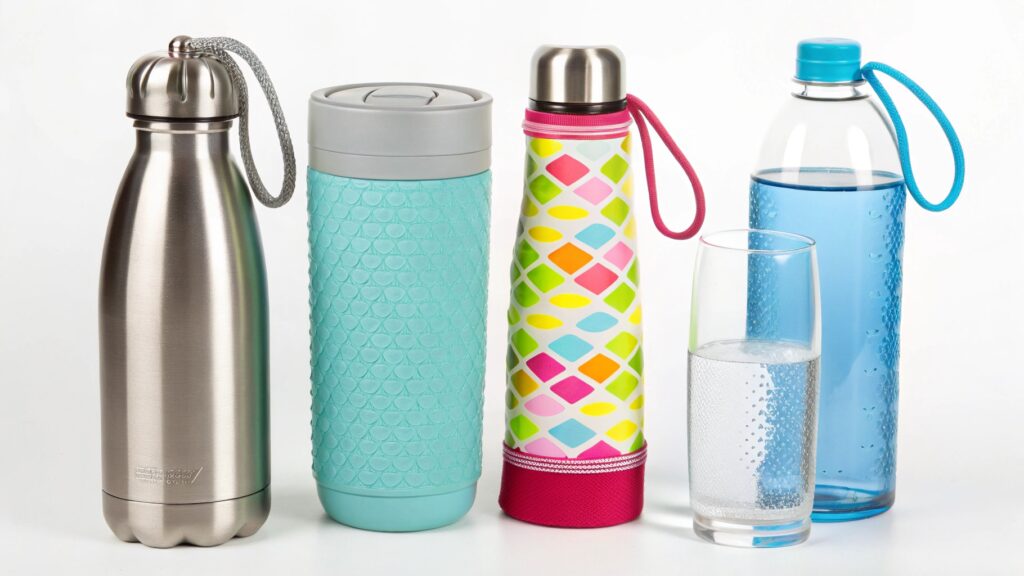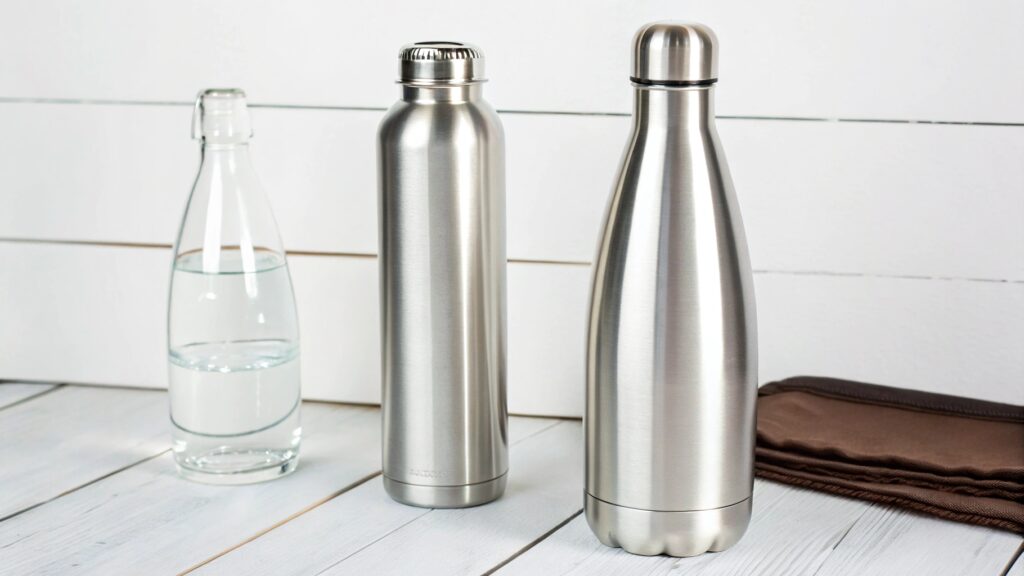What's the best water bottle for you?
Are you asking yourself, "What's the best water bottle?" You're actually wondering what lifestyle you want to support. The "best" bottle is not a one-size-fits-all answer; it reflects how, when, and why you hydrate.
The best water bottle balances function, form, and feeling, aligning with your personal hydration habits and lifestyle. While stainless steel excels at insulation, plastic offers portability, and glass provides purity. The ideal choice is durable, encourages consistent use, and becomes a part of your daily rhythm.

I've seen many people search for the perfect bottle, and it's always more about their daily life than the bottle itself. When you find the right one, it becomes a partner in your hydration journey, not just a container.
Which is better: plastic or stainless steel water bottles?
Are you trying to decide between plastic and stainless steel1 water bottles? Many people face this choice, wondering about the pros and cons of each material.
Choosing between plastic and stainless steel water bottles depends on your priorities; stainless steel offers superior insulation and durability, while plastic provides lightweight portability and affordability. Your ideal choice should align with your daily activities, budget, and environmental considerations.

I've learned that what works for one person might not work for another. It truly comes down to understanding your needs. I've used both extensively, and each has its place.
When should you choose stainless steel over plastic?
Choosing between stainless steel and plastic water bottles2 often depends on what you value most in a bottle. Stainless steel offers several key advantages that make it a better choice in specific situations. I often recommend stainless steel when durability and temperature retention are top priorities. For instance, if you're someone who spends a lot of time outdoors, like hiking or at a construction site, a stainless steel bottle can withstand drops and bumps much better than a plastic one. Plus, it keeps your water cold for hours, which is a huge benefit on a hot day. I remember a client who worked in logistics, constantly on the go. He switched to a vacuum-insulated stainless steel bottle and told me it changed his hydration habits because his water was always at the perfect temperature, no matter where he was.
Here's a breakdown of why stainless steel might be better:
| Feature | Stainless Steel | Plastic |
|---|---|---|
| Durability | Stainless steel is very resistant to dents, scratches, and breakage. It can withstand rough handling and last for many years. This means you won't need to replace it often. It's a long-term investment. | Plastic bottles can crack or break if dropped. They also show wear and tear more quickly. This means they might need replacing more often. They are not as robust. |
| Insulation | Many stainless steel bottles have vacuum insulation, keeping drinks cold for up to 24 hours and hot for up to 12 hours. This is great for all-day use. Your drinks stay at the right temperature. | Plastic bottles offer little to no insulation. Drinks will quickly reach room temperature. This means your water might not stay cold on a warm day. They are not designed for temperature control. |
| Safety | Stainless steel is a non-reactive material, meaning it does not leach chemicals into your drinks. This makes it a very safe option. You do not have to worry about unwanted substances in your water. | Some plastic bottles, especially older ones, may contain BPA or other chemicals that can leach into water. While many newer plastics are BPA-free, concerns still exist. It is important to check the type of plastic. |
| Taste & Odor | Stainless steel does not retain flavors or odors from previous drinks. You can easily switch between water, coffee, or juice without lingering tastes. Your drinks will always taste fresh. | Plastic can absorb flavors and odors over time, making it hard to get rid of lingering tastes. This can affect the taste of your fresh water. It might need more thorough cleaning. |
| Environmental Impact | A durable stainless steel bottle can be used for many years, reducing waste. It is also recyclable at the end of its life. This makes it a more eco-friendly choice in the long run. You are contributing less to landfill. | While reusable plastic bottles are better than single-use ones, they have a shorter lifespan and are harder to recycle than stainless steel in many areas. This means they may end up in landfills more often. Their environmental footprint can be larger over time. |
| Maintenance | Stainless steel bottles are generally easy to clean and are often dishwasher safe. They do not scratch easily, so cleaning brushes are safe to use. This makes them low maintenance. | Plastic bottles can be harder to clean thoroughly, and scratches can harbor bacteria. Some plastics are not suitable for dishwashers. This means they might require more careful cleaning by hand. |
Which bottle is best for drinking water?
Are you confused about which type of bottle is truly best for drinking water? It's a common question, and the answer depends on your priorities for daily hydration.
The best bottle for drinking water is one that consistently supports your hydration habits, blending personal preference with practical features like durability, ease of cleaning, and material safety. While different materials offer unique benefits, the ideal choice is ultimately the bottle you'll reliably use every day.

I've observed that the "best" bottle is often the one you forget you're carrying because it fits so seamlessly into your life. It's not about the brand or the latest trend; it's about what encourages you to drink more water.
What are the overlooked features that make a water bottle great?
When we talk about what makes a water bottle "great," we often focus on the obvious things like material or insulation. But in my experience, the truly great water bottles have subtle features that go unnoticed until you use them daily. These are the things that make a bottle integrate perfectly into your life, encouraging consistent hydration. It's about how the bottle feels in your hand, how easily it fits into your bag, or even the way it visually prompts you to take a sip. For instance, I once had a bottle that had a perfectly designed loop on the cap. It seemed like a small detail, but it made carrying the bottle so much easier, and I found myself taking it everywhere, leading to much better hydration habits.
Here are some often overlooked features that contribute to a great water bottle:
| Overlooked Feature | Impact on User Experience |
|---|---|
| Lid Design & Opening | A good lid design prevents leaks and is easy to open and close with one hand. A wide opening allows for easy cleaning and adding ice cubes. This makes daily use much more convenient. |
| Comfortable Grip | How the bottle feels in your hand matters. Textures, ergonomic shapes, or a slim profile can make it more comfortable to hold, especially when full. This encourages you to carry it more often. |
| Portability & Fit | Does it fit in your car's cup holder? Your backpack's side pocket? A bottle that fits seamlessly into your daily carry makes it more likely to be used. This means less hassle when you're on the go. |
| Visual Cues & Aesthetics | A visually appealing bottle or one with subtle markers (like time stamps) can serve as a constant, gentle reminder to drink water. If you like how it looks, you're more likely to use it. This subtly promotes hydration. |
| Ease of Cleaning | A bottle that's hard to clean can quickly become a breeding ground for bacteria or develop smells. Wide mouths and simple designs are much easier to maintain, encouraging regular use. This ensures your water is always fresh. |
| Material Finish & Feel | Beyond the material type, the finish (e.g., matte, glossy) can impact how the bottle feels. A pleasant tactile experience can make drinking from it more enjoyable. This adds to the overall positive experience. |
| Durability of Components | It's not just about the bottle body; hinges, seals, and straps must also be durable. A broken lid renders an otherwise good bottle useless. This ensures the bottle lasts as long as you need it to. |
| Minimal Noise | Bottles that don't clang when set down or make a loud noise when you open them can be a pleasant feature, especially in quiet environments like offices. This makes the bottle less distracting. |
| Flow Rate | The speed at which water comes out of the spout or straw can greatly affect the drinking experience. Some prefer a fast flow, others a controlled sip. This impacts how comfortably and quickly you can hydrate. |
| Environmental Statement | Using a reusable bottle, regardless of material, is a statement of intention against single-use plastics. The "best" bottle is one you choose to keep using, reducing waste. This reflects a commitment to sustainability. |
What is the healthiest water bottle to drink from?
Are you concerned about finding the healthiest water bottle3 to drink from? Many people worry about chemicals leaching into their water, and it's a valid concern.
The healthiest water bottle to drink from is generally considered to be one made from inert materials like food-grade stainless steel or glass, as they do not leach chemicals into your water. These materials offer the purest drinking experience, minimizing potential health risks and ensuring your water remains untainted.

I've found that when health is the top priority, focusing on the material is key. You want something that ensures your water stays as pure as possible from bottle to sip.
Why do material choices impact your health?
The material your water bottle is made from directly impacts your health, primarily through the potential for chemical leaching. When you fill a bottle with water, especially if the water is warm or if the bottle has been sitting for a while, chemicals from the material can transfer into your drink. This is why material choice is so important for health-conscious individuals. For example, older plastic bottles often contained BPA (Bisphenol A), a chemical linked to various health concerns. While many plastics are now BPA-free, concerns about other potential hormone-disrupting chemicals still exist. Glass and stainless steel, on the other hand, are non-reactive, meaning they do not release any substances into your water. This ensures your water remains pure and free from unwanted contaminants. I always advise my clients who prioritize health to consider these materials first.
Here's how different materials affect your health:
| Material | Health Implications |
|---|---|
| Glass | Pros: Glass is completely inert, meaning it does not leach any chemicals into your water, regardless of temperature or how long the water sits. It also does not retain flavors or odors, ensuring a pure taste. It is easy to clean thoroughly. Cons: Glass is fragile and can break easily if dropped. This makes it less suitable for active lifestyles or for children. The weight can also be a factor for portability. |
| Food-Grade Stainless Steel | Pros: Like glass, food-grade stainless steel (e.g., 18/8 or 304 grade) is non-reactive and does not leach chemicals into your water. It is very durable and resistant to breakage, making it excellent for outdoor and active use. It also does not retain flavors. Many come with vacuum insulation, keeping water cold for long periods, which can encourage more hydration. Cons: Stainless steel bottles can be heavier than plastic or aluminum. They are also usually more expensive upfront. The exterior can dent if dropped hard. |
| Tritan Plastic | Pros: Tritan is a type of plastic that is BPA-free, BPS-free, and generally designed to be free of estrogenic activity. It is lightweight, durable, and shatter-resistant, making it a popular choice for active individuals and children. It is also more affordable than glass or stainless steel. Cons: While considered safer than older plastics, some concerns remain about the long-term effects of any plastic on health. It can retain odors over time. It is not as environmentally friendly as stainless steel or glass in terms of end-of-life disposal. It can scratch, which may harbor bacteria if not cleaned properly. |
| Aluminum | Pros: Aluminum bottles are lightweight and often more affordable than stainless steel. They are durable. Cons: Aluminum is a reactive metal and must be lined with an epoxy or ceramic coating to prevent aluminum from leaching into the water. If this lining is scratched or damaged, aluminum can leach into the drink. This lining can also degrade over time. It is generally not recommended for hot liquids due to potential leaching from the lining. Concerns exist about the chemicals in the lining. |
| Silicone | Pros: Silicone is flexible, lightweight, and often used for collapsible bottles. It is generally considered inert and free of harmful chemicals. It is durable. Cons: While generally safe, some silicone products can have a slight odor or taste that can transfer to water, especially when new. It can be more difficult to clean thoroughly than rigid materials like glass or stainless steel. It is not as rigid as other materials, so it might not protect water from impact as well. |
Conclusion
The best water bottle aligns with your lifestyle, balancing function, form, and feeling. Choose one that supports your hydration habits and becomes a daily companion.
-
Explore the advantages of stainless steel bottles, including durability and insulation, to make an informed choice. ↩
-
Learn about the benefits and drawbacks of plastic bottles to understand their impact on hydration and the environment. ↩
-
Find out which materials are safest for drinking water and why they matter. ↩





